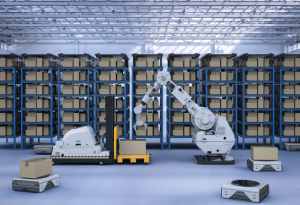Why is Robots-as-a-Service so Important in 2023?
 In the first quarter of this century, we’ve seen huge leaps in technological advancement and a wholesale movement towards automation in industry. We’ve also seen global events that destabilise supply chains, workforces and markets at a rate that taught us the value of flexible, versatile solutions that can adapt to changes in business needs. However, the uptake of automation in the UK is still relatively low. One barrier to automation is the perceived high cost relative to benefits, particularly in manufacturing sectors. The Robots-as-a-Service model changes the game, providing high-quality robotics, software and maintenance in a cost-effective, versatile package.
In the first quarter of this century, we’ve seen huge leaps in technological advancement and a wholesale movement towards automation in industry. We’ve also seen global events that destabilise supply chains, workforces and markets at a rate that taught us the value of flexible, versatile solutions that can adapt to changes in business needs. However, the uptake of automation in the UK is still relatively low. One barrier to automation is the perceived high cost relative to benefits, particularly in manufacturing sectors. The Robots-as-a-Service model changes the game, providing high-quality robotics, software and maintenance in a cost-effective, versatile package.
What is Robotics-as-a-Service (RaaS)?
 Many people are familiar with the concept of Software-as-a-Service (SaaS). You pay a monthly subscription fee to use a software package, you no longer purchase a copy to install on your device. Updates are then provided so that you gain all of the latest features once they are available.
Many people are familiar with the concept of Software-as-a-Service (SaaS). You pay a monthly subscription fee to use a software package, you no longer purchase a copy to install on your device. Updates are then provided so that you gain all of the latest features once they are available.
RaaS describes a business model in which robotics companies offer a subscription-based contract or pay-as-you-go service for the use of industrial robotic devices. With a subscription service, companies can access autonomous mobile robots (AMRs) or Robotic arms and attachments, automating material handling tasks without buying robots outright.
This model provides easy robotic automation implementation, avoiding high up-front investment and costly maintenance call-outs. RaaS also shifts automation costs from a capital expense to an operational expense. Just as paying your employees each month, you should pay for your automated solution in the same way. RaaS is a shift from ownership to usership in which businesses pay for the outcomes, rather than the hardware.
How does providing Robots-as-a-Service work?
With Robots-as-a-Service, companies can purchase licensing for a physical robot, the company will not own the robotic unit or the operating technology, but hire autonomous mobile robots (AMRs) and the solution for a recurring fee. This means the cost of entry into robotic automation is far lower than it would be for companies purchasing robots outright, without compromising on quality and functionality.
Seasonal Scaling for Peak Demand
By treating robotics as an overhead cost rather than capital expenditure, companies benefit from a degree of flexibility. In times of high demand, warehouses and manufacturers hire seasonal and temporary workers for the additional workload. In the same way, businesses with RaaS contracts can make up for the shortfall in labour availability by increasing the number of AMRs and associated hardware in the facility.
Automation solutions work alongside workers and take on travelling and lifting tasks for them, allowing staff to reserve their energy for those jobs which require more human understanding. When the peak season is over, you can return the additional hardware to the supplier until you need them again.
Access to Regular Maintenance
Support and maintenance are built into the RaaS contract model. Businesses can access technical support from engineers who are familiar with the AMR type. Maintenance visits can be scheduled ahead of time, and replacing defective equipment can happen much more quickly and affordably than when units are bought outright.
Accessible Automation for SMEs
Using Robotics-as-a-Service, companies can open doors to higher productivity, greater efficiency and a more fulfilled workforce for small- and medium-sized businesses. As discussed, the assumption that automation requires a considerable capital investment is a barrier to many SMEs, but with this business model, Industry 4.0 is within reach.
Many businesses are already comfortable with this type of model, thanks to the huge success of Software-as-a-Service programmes. Robots-as-a-Service contracts can unlock automation with lower initial investments and lower risk, making budget approval far more likely.
Shorter ROI
With lower initial investments, a company can see returns within months rather than years. RaaS provides the same first-class automation and all the gains in efficiency, throughput and accuracy.
Flexible Automation
AMRs are some of the most versatile robotic material-handling tools around. They can be instructed to travel throughout facilities, transporting items from storage to packing, assisting with palletisation, unloading deliveries and more. As well as the freedom to change the number of AMRs you use, RaaS allows access to flexible, adaptable material handling.
A typical AMR has a low, flat surface to carry totes, boxes or pallets. Guidance Automation has developed a number of AMR attachments in the form of tops and modules, providing extra functionality. These include conveyors, forklifts and pick-to-light attachments, making our AMRs more collaborative and versatile.
Simplify your Automation Process with RaaS
Guidance Automation offers consultancy and implementation services to support the adoption of robotics and other automation systems. We offer a Robotics-as-a-Service package to enable businesses of all sizes to access automation. If you think your business could benefit from automation with a lower initial investment, a support package and faster ROI, you can speak to our automation consultants and set up an initial site visit.



